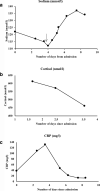A case of adrenal infarction in a patient with COVID 19 infection
- PMID: 32922854
- PMCID: PMC7465735
- DOI: 10.1259/bjrcr.20200075
A case of adrenal infarction in a patient with COVID 19 infection
Abstract
This case report highlights an unusual presentation of acute adrenal infarction in a Covid-19 patient who presented with abdominal symptoms and hyponatraemia. We discuss the recent literature reviewing how Covid-19 creates a hypercoaguable state, with acute adrenal infarction as a possible prothrombotic complication.
© 2020 The Authors. Published by the British Institute of Radiology.
Figures




References
Publication types
LinkOut - more resources
Full Text Sources

